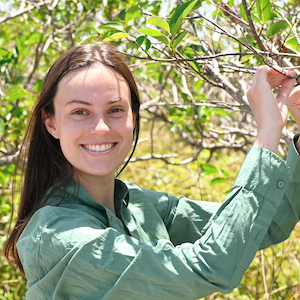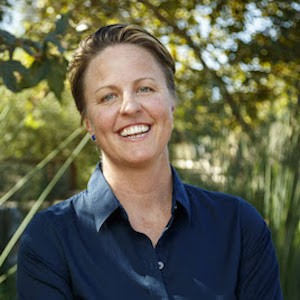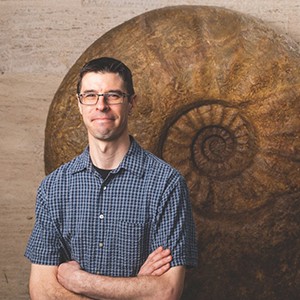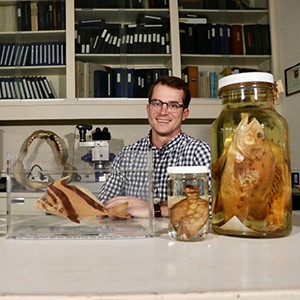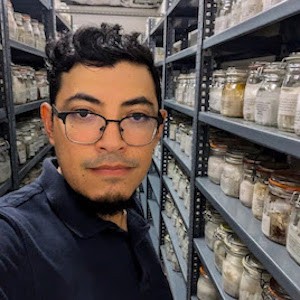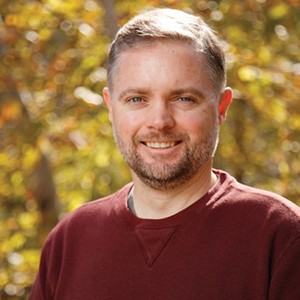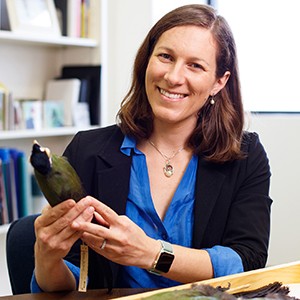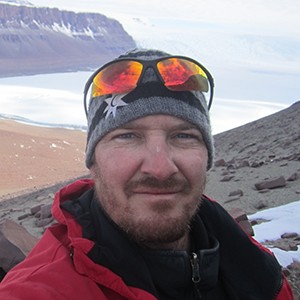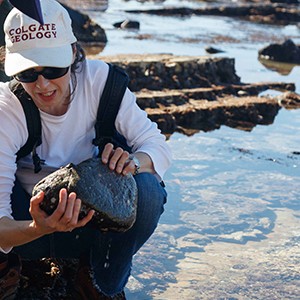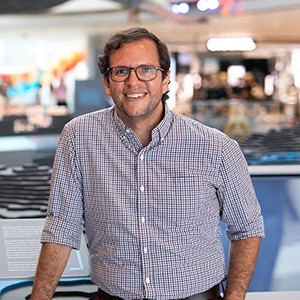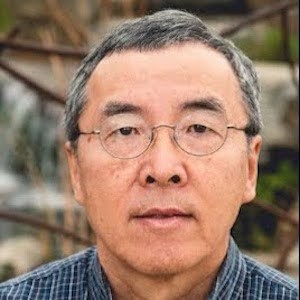NHMLAC Mentors & Departments
Megan Barkdull
Assistant Curator, Department of Entomology
Research area: I oversee the museum’s collection of insects, and my research focuses on understanding the evolutionary and developmental processes that have generated the tremendous diversity of insects that we find on Earth today. I’m also interested in using genetic tools to understand how humans are impacting insects.
Favorite thing about being a researcher: My favorite thing about being a researcher is getting to use a wide variety of data to make new discoveries about insects. One day I might be in the field collecting ants, the next I’m in the lab extracting DNA, and I might finish the week by taking photos of hundred-year-old museum specimens. It’s impossible to get bored!
Kayce Bell
Associate Curator, Terrestrial Mammals
Research Area: I oversee the terrestrial mammalogy collection and focus my research on small mammal diversity and parasites.
Favorite thing about being a researcher: I love my research because there is so much left to discover, even in groups that are relatively well-studied, such as mammals. In particular, I enjoy learning how species interact with their surroundings and other species and how those interactions shape their evolution and diversity.
Amy Gusick
Curator, Anthropology / NAGPRA officer
Research Area: I am an archaeologist who oversees research and management of the
archaeology and ethnology collections at NHMLA where we focus on providing access to descendant populations and collaborative projects that uplift indigenous histories. I conduct research focused on human-environmental dynamics, the development of maritime societies, peopling of the Americas, and maritime cultural landscapes using both terrestrial and underwater methods and in partnership with traditional custodians of the lands on which I work.
Favorite thing about being a researcher: My favorite aspects of being a researcher are the collaborative nature of the work that I conduct and the ability to be creative and inventive. Because my research focus necessitates a broad understanding of paleolandscapes and paleoecology, the projects in which I am involved include many different types of scientists and indigenous knowledge holders. Some of this research includes developing new methods and even new technologies to effectively conduct themresearch. This creates an environment where my colleagues and I can be creative and “think outside the box” to create new methods to collect the data we need to better understand human-environmental dynamics through time.
Austin Hendy
Assistant Curator, Invertebrate Paleontology
Research Area: I oversee the invertebrate paleontology collections and focus my research on marine biogeography, paleoecology, and paleo-environments preserved in Earth's recent geological record.
Favorite thing about being a researcher: I love my research because it enables discovery and understanding of the world around us, and my work allows me to document the past and present and postulate on the future of our changing planet and biodiversity. I consider myself to be a time traveling marine biologist, using our valuable museum collections and new field discoveries to travel back in time to reconstruct past environments and species interactions, and add to the scientific knowledge of evolution and earth systems.
Bill Ludt
Associate Curator, Ichthyology
Research Area: I oversee the ichthyology collection and focus my research primarily on understanding how the Earth's fishes are related to one another and determining what factors have influenced where fishes occur and how that has changed over time.
Favorite thing about being a researcher: My favorite part about doing research is learning more about life on our planet. Fishes can be difficult to observe in the wild, and each discovery we make about them and how they evolved can feel like solving an unsolved mystery.
Rodrigo Monjaraz Ruedas
Assistant Curator, Entomology
Research Area: I oversee the entomology collection (arachnids and minor orders), and I focus my research on evolution, diversity, and phylogeography of arachnids using bioinformatic tools and genomics, much of my research centers on groups like Pedipalpi (short-tailed whip scorpions, whip spiders, and whip scorpions) and trapdoor spiders.
Favorite thing about being a researcher: One of my favorite parts about my job is the opportunity to travel to remote places and discover new and hidden species; looking at their morphology through the microscope is always an amazing feeling. I also love getting a glimpse at the complex evolutionary history of arachnids using modern and innovative research tools, having the opportunity to answer questions and understand the relationships of arachnids and their vast diversity is certainly among my greatest passions.
Greg Pauly
Curator, Herpetology
Research Area: I oversee the herpetology collection and focus my research on the conservation, ecology, and evolution of reptiles and amphibians, with much of my work examining impacts of urbanization.
Favorite thing about being a researcher: My favorite part about research is making new discoveries, whether those be through field or lab work; I love that we get to identify questions of interest to us, design studies to answer those questions, and then learn new information. I also take a great deal of pride in not only building scientific knowledge through publishing research but in building the natural history collections that will determine the scientific questions future researchers will be able to answer.
Allison Shultz
Associate Curator, Ornithology
Research Area: I oversee the ornithology (birds) collection and focus my research on feather evolution and evolution in urban environments.
Favorite thing about being a researcher: I love that in my job I get to ask the questions that I'm curious about and be the one to discover the answers to those questions. I love both observing nature in the field, as well as applying exciting new technologies to specimens that were collected over a century ago to understand nature and biodiversity in a way we couldn't before.
Nathan Smith
Curator, Dinosaur Institute
Research Area: I oversee the dinosaur and Mesozoic vertebrate collection and focus my research on early dinosaur evolution and diversification.
Favorite thing about being a researcher: My favorite part of my job is probably fieldwork and discovering and collecting new fossils from amazing places around the world. I also enjoy that paleontology is such an interdisciplinary science that allows us to bring together a diverse toolkit of skills and methods to answer questions about Earth's history.
Jann Vendetti
Associate Curator, Malacology
Research Area: I oversee the malacology (mollusk) collection and focus my research on the morphology and genetics of native and introduced snails in Southern California.
Favorite thing about being a researcher: My favorite thing about research is that I get to use a variety of techniques to ask and answer questions about native and non-native mollusk species. I also enjoy exploring, learning about, and collecting snails from across Southern California, in urban environments, the marine intertidal, Mojave desert, and Verdugo and San Gabriel Mountains.
Jorge Velez-Juarbe
Associate Curator, Marine Mammals
Research Area: I oversee the collections of modern and fossil marine mammals and my research focuses on the evolutionary history of sirenians, pinnipeds and cetaceans, and the origins of terrestrial and marine vertebrates from the Caribbean region.
Favorite thing about being a researcher: One of the favorite parts of my job is fieldwork, which has allowed me to travel to multiple localities across the Americas and the Caribbean to discover the fossilized remains of new and exciting extinct species. My other favorite aspect is studying fossils in great detail to figure out and disentangle their relationships, evolutionary history and the role they played in the ancient environments they lived.
Xiaoming Wang
Curator, Vertebrate Paleontology
Research area: I am interested in the evolution of mammalian predators (order Carnivora) during the last 65 million years. I do research on their fossil records, how they function, and how they evolve through time.
Favorite thing about being a researcher: Discovery of cool fossils always ranks high in my favorite things. Traveling to many parts of the world, such as Tibet, Mongolia, Mexico, and here in Mojave Desert, in search of long-extinct animals is perhaps the most exciting work as a vertebrate paleontologist. Studying the predator-prey relationship for the extinct carnivorans allows room for imagination in the ancient world.
